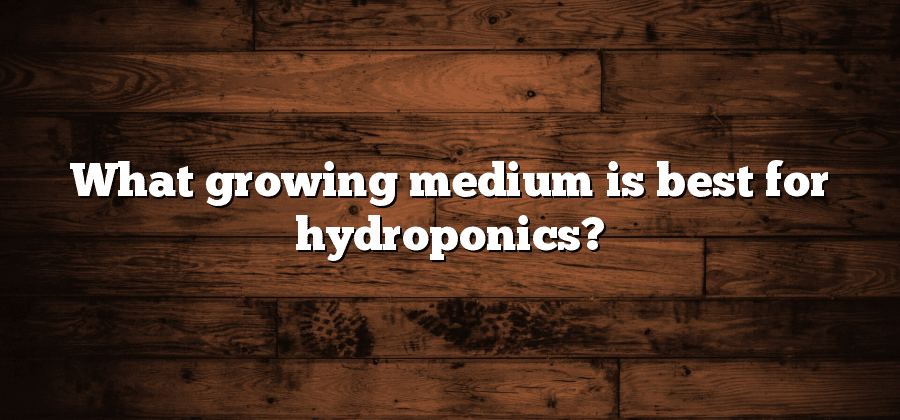Coco Coir as a Hydroponic Medium
Hydroponics is becoming increasingly popular as a method of cultivating plants without the use of soil. One of the most commonly used mediums in hydroponic systems is coco coir. Coco coir, derived from the fibrous husk of coconuts, offers numerous advantages for plant growth and development.
Firstly, coco coir has excellent water retention capabilities, allowing plants to easily absorb the water and nutrients they need. This is particularly beneficial in hydroponic systems, where oxygen and water must be carefully balanced to ensure optimal plant health. Additionally, coco coir has excellent drainage properties, preventing waterlogged conditions that can lead to root rot. This makes it an ideal medium for a variety of plants, including vegetables, herbs, and flowering plants.
Perlite: Lightweight and Porous Medium for Hydroponics
Perlite is a highly regarded medium in the world of hydroponics due to its lightweight and porous nature. This volcanic rock is a popular choice among hydroponic growers due to its ability to provide adequate aeration and drainage for the plants.
One of the main advantages of using perlite as a medium is its ability to retain moisture while still allowing excess water to drain away. This is crucial in hydroponic systems, as overwatering can lead to root rot and other detrimental conditions. Additionally, its porous structure allows for increased oxygenation to the roots, promoting healthy and efficient growth. Moreover, perlite is also known for its pH neutrality, which ensures that the nutrient solution remains stable and balanced for optimal plant development.
Rockwool: A Popular Choice for Hydroponic Systems
Rockwool, a widely favored choice among hydroponic enthusiasts, is renowned for its versatility and effectiveness as a growing medium. Made from volcanic rock and limestone, it offers excellent water retention capabilities while still maintaining adequate drainage. The fibrous structure of rockwool provides an ideal environment for root growth, ensuring the plants receive sufficient oxygen and nutrients. Its sterile composition also minimizes the risk of pests and diseases, further enhancing its appeal in hydroponic systems.
One of the key advantages of rockwool is its pH neutrality. This inherent neutrality allows growers to have greater control over nutrient uptake, enabling them to customize the nutrient solution based on the specific needs of the plants being cultivated. Moreover, rockwool can be reused for multiple growing cycles, making it a cost-effective option in the long run. Its durability and resistance to compression ensure that it retains its shape and structure, providing stable support for plants throughout their growing journey.
Clay Pellets for Hydroponic Growing Medium
Clay pellets, also known as expanded clay aggregate (ECA), are a popular choice for growing medium in hydroponic systems. These small, lightweight spherical pellets are made by heating clay to high temperatures, which causes them to expand and develop a porous structure. One of the key benefits of clay pellets is their ability to retain water while still providing good drainage, making them a suitable option for a range of hydroponic setups.
In addition to their excellent water retention capabilities, clay pellets also offer good air circulation around the roots of plants, promoting healthier growth and preventing the buildup of harmful pathogens. Their neutral pH levels ensure that they do not interfere with nutrient solutions, making them compatible with a wide variety of crops. Moreover, clay pellets are durable and inert, providing stability and support to plants without decomposing or breaking down over time.
When using clay pellets as a hydroponic growing medium, it is important to rinse them thoroughly before use to remove any dust or debris. Additionally, it is advisable to periodically flush the pellets with water to prevent salt buildup. Overall, clay pellets provide a reliable and versatile option for hydroponic growers, offering a balance between water retention and drainage to facilitate optimal plant growth.
Vermiculite: Retaining Water in Hydroponics
Vermiculite, a natural mineral that expands when heated, is well-known for its ability to retain water in hydroponics. This lightweight and moisture-absorbent material is commonly used as a medium in hydroponic systems to promote healthy plant growth.
One of the primary advantages of using vermiculite in hydroponics is its high water-holding capacity. The expanded particles of vermiculite have a unique structure that allows them to retain moisture, ensuring a consistent and steady supply of water to the plants. This characteristic is particularly beneficial in hydroponics, where plants rely on a nutrient solution instead of soil for their growth. With vermiculite as the growing medium, the plants can access water and nutrients more efficiently, resulting in healthier and more vigorous growth. Additionally, vermiculite also aids in maintaining a stable root temperature, preventing excessive heat that could potentially harm the plants.
The exceptional water retention properties of vermiculite make it an excellent choice for hydroponic systems where the availability of water needs to be carefully regulated. Its lightweight nature also contributes to the overall ease of managing and maintaining a hydroponic setup. Moreover, vermiculite holds onto fertilizers and releases them slowly, ensuring that plants receive a steady supply of nutrients over time. However, it is important to note that vermiculite alone may not provide adequate support and aeration to plant roots, which is why it is often mixed with other hydroponic mediums for optimal results. In the next section, we will explore the benefit of combining vermiculite with other materials to create a well-balanced hydroponic growing medium.






